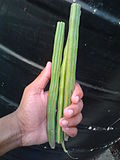 |
| Moringa being washed |
 |
| Drying the Moringa leaves |
From Wikipedia: It is a fast-growing, drought-resistant tree, native to the southern foothills of the Himalayas in northwestern India, and widely cultivated in tropical and subtropical areas where its young seed pods and leaves are used as vegetables. It can also be used for water purification and hand washing, and is sometimes used in herbal medicine.
| Nutritional value per 100 g (3.5 oz) | |
|---|---|
| Energy | 64 kcal (270 kJ) |
8.28 g
|
|
| Dietary fiber | 2.0 g |
1.40 g
|
|
9.40 g
|
|
| Vitamins | |
| Vitamin A equiv. |
(47%)
378 μg |
| Thiamine (B1) |
(22%)
0.257 mg |
| Riboflavin (B2) |
(55%)
0.660 mg |
| Niacin (B3) |
(15%)
2.220 mg |
(3%)
0.125 mg |
|
| Vitamin B6 |
(92%)
1.200 mg |
| Folate (B9) |
(10%)
40 μg |
| Vitamin C |
(62%)
51.7 mg |
| Minerals | |
| Calcium |
(19%)
185 mg |
| Iron |
(31%)
4.00 mg |
| Magnesium |
(41%)
147 mg |
| Manganese |
(17%)
0.36 mg |
| Phosphorus |
(16%)
112 mg |
| Potassium |
(7%)
337 mg |
| Sodium |
(1%)
9 mg |
| Zinc |
(6%)
0.6 mg |
The leaves are the most nutritious part of the plant, being a significant source of B vitamins, vitamin C, provitamin A as beta-carotene, vitamin K, manganese, and protein, among other essential nutrients. When compared with common foods particularly high in certain nutrients per 100 g fresh weight, cooked moringa leaves are considerable sources of these same nutrients. Some of the calcium in moringa leaves is bound as crystals of calcium oxalate though at levels 1/25th to 1/45th of that found in spinach, which is a negligible amount.
The leaves are cooked and used like spinach and are commonly dried and crushed into a powder used in soups and sauces.
Drumsticks
drumstick
The immature seed pods, called "drumsticks", are commonly consumed in South Asia. They are prepared by parboiling, and cooked in a curry until soft. The seed pods/fruits, even when cooked by boiling, remain particularly high in vitamin C (which may be degraded variably by cooking) and are also a good source of dietary fiber, potassium, magnesium, and manganese.



Thanks for the Information...I'll book mark your Blog...
ReplyDelete